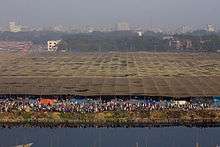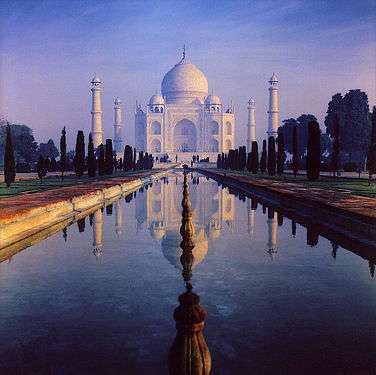Bishwa Ijtema

 |
| Part of a series on |
| Islamic culture |
|---|
| Architecture |
| Art |
| Dress |
| Holidays |
| Literature |
| Music |
| Theatre |
|
The Bishwa Ijtema (Bengali: বিশ্ব ইজতেমা, meaning Global Congregation) is an annual gathering of Muslims in Tongi, by the banks of the River Turag, in the outskirts of Dhaka, Bangladesh. It is the second largest Islamic congregation after the Hajj.[1][2][3][4] It is one of the largest peaceful gatherings in the world. The Ijtema is a prayer meeting spread over three days, during which attending devotees perform daily prayers while listening to scholars reciting and explaining verses from the Quran. It culminates in the Akheri Munajat, or the Final Prayer, in which millions of devotees raise their hands in front of Allah (God) and pray for world peace.[2][5] The Ijtema is considered a demonstration of Muslim unity, solidarity, mutual love and respect and an opportunity to reiterate their commitment to Islamic values.[6]
The Ijtema is non-political and therefore it draws people of all persuasion. It is attended by devotees from 150 countries.[1] The majority of its devotees come from across Bangladesh, the world's third largest Muslim majority country.
Speakers include Islamic scholars from various countries.
Etymology
Ijtema is an Arabic word which means public gathering.[6] In Bengali, the event is known as the "Bishwa Ijtema". Bishwa is a Bengali word which means world.
Organization
The event is organized in January by the Bangladeshi chapter of the Tablighi Jamaat, an orthodox Sunni movement. The congregation takes place in an area which spans over five square kilometers in Tongi, an outer suburb north of Dhaka.[6] An extensive tent is created in the area with the help of the Government of Bangladesh. Transport is provided by state-run companies, including Biman Bangladesh Airlines, the Bangladesh Railway and the Bangladesh Road Transport Corporation (BTRC). The Bangladesh Armed Forces assists by arranging infrastructure. Despite the large number of devotees living within a confined space, generally there are very few problems of sanitation, cooking, and internal movements. It is believed to be possible because of the minimalist approach adopted by the devotees. Devotees reduce their own requirements and develop a respect for others' requirements. During the Final Prayer, huge crowds stretch from the Ijtema ground in Tongi into the Dhaka metropolitan area. Schools and offices are declared closed on the occasion.
History
The Bengali Tabhlighi Jamaat movement started in Dhaka, East Bengal during the 1950s. The first Ijtemas were organized in Chittagong (1954) and Narayanganj (1958), followed by Ijtemas at the Ramna Race Course in Dhaka in 1960, 1962 and 1965.[6] Due to the increasing rate of participants, the government of East Pakistan allowed organizers to schedule the event annually by the River Turag in 1967.[6] Later, the government of Bangladesh allotted 160 acres of land for exclusively holding the event.[6]
Number of devotees
In 2001, the number of attendees was 2 million.[6] In 2010, the number was 5 million.[1]
Foreign devotees
Estimates of foreign devotees stands at 20,000-50,000. They come from various regions, including the South Asian Subcontinent, Russia and Central Asia, Europe, Southeast Asia, the Middle East, North Africa and the United States.[7][6]
Overcrowding and weather
Due to increasing overcrowding, the Ijtema was divided into two segments with an interval of seven days from 2010.[6] The first phase is allowed for devotees from 32 designated Bangladeshi districts. The second phase allows devotees from the remaining districts of the country.[6] Foreign devotees are allowed in both phases.
In 2008, the event had to be cut short to only one day due to rain and cold weather which left three attendees dead.[8]
Comparison with other Muslim gatherings
Unlike the Hajj, the Ijtema is not one of the five pillars of Islam..[3] Other major congregations in the Muslim world include Shia pilgrimages in Karbala.
Gallery
-

Devotees in the Dhaka metropolitan area
-
Devotees at a Dhaka railway station
-
Devotees on the Bangladesh Railway
See also
References
- 1 2 3 "What is the festival of Bishwa Ijtema and where is it held?".
- 1 2 "Muslims attend Bangladesh prayer". 5 December 2004 – via bbc.co.uk.
- 1 2 "Muslims condemn Paris massacre at Bangladesh's mini-Hajj".
- ↑ "Bangladesh Muslim festival ends". 8 January 2001 – via bbc.co.uk.
- ↑ "Akheri Munajat ends seeking world peace". 10 January 2016.
- 1 2 3 4 5 6 7 8 9 10 "Viswa Ijtema - Banglapedia".
- ↑ "Millions of Muslims gather in Bangladesh".
- ↑ Sarkar, Kailash (26 January 2008). "Ijtema cut short for inclement weather". The Daily Star.